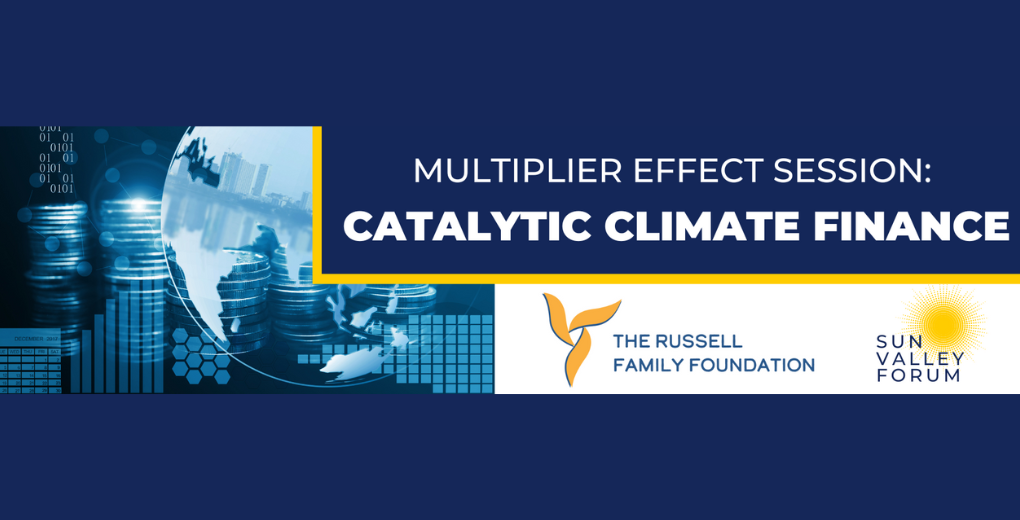Case Studies
Multiplier Effect: Partnering to Accelerate Climate Solutions: Catalytic Climate Finance Session Summary.

The Sun Valley Forum Multiplier Effect Sessions
The Sun Valley Forum is hosted annually by Christensen Global as a climate solutions accelerator. The Forum’s Multiplier Effect sessions provide a collaborative platform for driving climate solutions forward. The sessions aim to accelerate specific initiatives by leveraging the deep knowledge, powerful reach, and resources within the Forum community, onsite and throughout the year.
Our Finance Challenge
We must urgently decarbonize our economies and draw down carbon from the atmosphere. To do so, we need alignment of policies and capital to deploy solutions at speed and scale. It is imperative that we come together and take decisive action, as stated in a recent Forbes article by CERES CEO Mindy Lubber, Scientists Warn Us That We Have Just Seven Years To Act, Here Are Seven Actions Investors And Companies Can Take In 2023.
There is a significant gap between current climate finance and the required investment flows to achieve net-zero emissions and sustainability goals. With only about 16% of climate finance needs being met, innovative solutions and collaboration were identified as essential drivers of change.
Two critical aspects of financing decarbonization and resilience are climate financial alignment and catalytic climate financing.
Climate Financial Alignment and Catalytic Climate Finance
Climate financial alignment involves aligning lending and investment decisions with long-term decarbonization targets. Catalytic climate financing uses innovative approaches and tools to de-risk and fund climate solutions. The session emphasized the importance of bridging financing gaps through catalytic capital. Catalytic capital is essential to bridge the financing gap and achieve the breadth and depth of impact that can solve global challenges. This type of financing, which accepts disproportionate risk and concessionary return, encourages third-party investment with the potential to close the gaps left by government and mainstream capital and the ability to accelerate the most effective solutions.
Our Finance Opportunity: By leveraging Sun Valley Forum community’s extensive and diverse expertise and reach, the session leaders and attendees worked to identify critical financing gaps and spark new action for greater impact.
Session Objectives
The Sun Valley Forum Multiplier Effect session on Catalytic Climate Finance was convened by The Russell Family Foundation on June 22, 2023. Tim Dunn of Terra Alpha Investments facilitated the gathering which prioritized solutions to finance decarbonization, including:
- Climate financial alignment, the process of aligning lending and investment decisions that lead to long-term decarbonization targets and catalytic climate financing
- The innovative financial approaches, and tools that de-risk and fund climate solutions deployment in the face of political, technology or other risk
The Multiplier Effect Session findings further reinforce the importance of these actions and highlight the urgent need for collaboration and innovative financing solutions. The outcomes focused on:
- Identifying key barriers, gaps, and opportunities
- Featuring solutions that are or can work
- Providing recommendations, announcing new commitments to action, and agreeing to new initiatives or collaborations to accelerate financial alignment for decarbonization
Priority Topics
During the Multiplier Effect session table facilitators and participants engaged in collaborative discussions and working groups on seven specific priority areas in the next seven years and how our collective action will make a significant difference:
1. Publishing Climate Transition plans – Brooks Preston, Managing Director of the Green Investment Group, Macquarie Asset Management
2. High-emitting sectors – Ivan Frishberg – Senior Vice President, Chief Sustainability Officer, Amalgamated Bank.
3. Support for a Just and Inclusive Transition – Javier Hernandez, Director, Avivar Capital
4. Effective Communication Strategies – Alex Thompson, Communications & Impact Expert
5. Climate Risk as Financial Risk – Ted Obenchain, Head of Commercial Development, riskthinking.AI Inc.
6. Government Policy and Resources – Andrew Wishnia, Partner, Cityfi
7. Nature Conservation – Agustin Silvani, Senior Vice President, Conservation Finance, Conservation International
Working Group Findings and Recommendations
The findings showcased diverse perspectives and actionable solutions
- Publishing Climate Transition Plans: Climate transition plans are urgently needed for corporations, state and municipal governments, and asset portfolios. Participants identified the need for clear standards and regulatory frameworks to guide plan development and facilitate the transition to a net-zero economy, the role of culture and governance in driving action, and transparent reporting of outcomes. Recommendation: Transition Plans need to be comprehensive, outline specific actions and include timelines for decarbonization, guided by clear standards and regulatory frameworks.
- High-Emitting Sectors: Sectors such as steel, cement, transport, real estate, and agriculture were recognized as high-emitting sectors that are also more difficult to decarbonize, given specific technology needs. The discussion also pertained to the other highest admitting sectors, including coal, oil, gas, and chemicals. Participants discussed drivers of change to accelerate decarbonization, including shareholder engagement, policy regulations and disclosure requirements, generational shifts, and the competitive dynamic between clean energy and legacy industries, including subsidized fossil fuels and industrial agriculture. Recommendation: Catalytic capital and engaged asset owners can play a powerful role by providing first-loss guarantees for new technology deployments and patient capital for longer-term returns. Fulfill the need for standards for common approaches, whether led by industry or regulation, to enable marketplace competition between different players in the sector to escalate ambition.
- Support for a Just and Inclusive Transition: A just transition focused on gender, individual, community, and country considerations is the necessary foundation for climate solutions. Barriers such as lack of education and regulatory obstacles were identified, and the importance of listening to and understanding community needs when considering capital solutions. Recommendation: Democratize the governance and ownership of capital and assets and incorporate social and economic justice considerations into climate action plans to address inequalities and avoid exacerbating disparities. Developing partnerships with community-based organizations and leveraging digital tools to make access to capital more efficient for low-income communities and communities of color, including capital stacks.
- Effective Communication Strategies: The participants highlighted the need to simplify the language used in climate crisis discussions to engage retail consumers and institutional investors better. Simplifying includes reducing complexity and clarifying climate finance definitions because complexity instills barriers to participation. The language needs to be less abstract, less academic, and easier to access to resonate with consumers and institutional investors. The lack of clarity can inhibit a conversation and subsequent investment if one is unsure what it is. Recommendation: Connect the climate crisis to the more accessible top-of-mind impacts such as health, freedom, jobs, and autonomy, and communicate the power of climate solutions to deliver a cleaner and safer world. Create a clear definition of climate finance of what is included and not. Create clear and actionable messages about what people can do and not always what they can’t, and tailor them to the target audience.
- Climate Risk as Financial Risk: Barriers to addressing climate risk were identified. These barriers include the lack of clean and properly constructed data to understand the full range of possible risks and opportunities related to climate and the associated financial impacts, the lack of standards and best practices, addressing cultural biases among investors, and how to incentivize long-term structural changes in high-emitting sectors. Recommendation: Solutions include implementing government standards and disclosure requirements, educating investors, and developing and implementing measurement and disclosure tools that include the value of nature, and enforcing existing environmental laws to protect nature and indigenous peoples’ rights.
- Government Policy and Resources: The participants emphasized connecting underserved and overburdened communities to resources available through government policies and programs, including the Inflation Reduction Act. A barrier that was identified was the huge amount of information, but lack of the right sort of information for consumers, banks, and venture capitalists that’s accessible and allows for: a more accessible version of applying for discretionary grants, leveraging blended capital opportunities for discretionary grants, and financing opportunities, whether its banking opportunities within the various U.S. agencies or layering funds from multiple federal agencies. More collaboration between governments and NGOs is critical to ensure effective policy implementation and equitable distribution of benefits. Recommendation: Provide more straightforward eligibility criteria for funding, bridge information gaps to better engage private equity and venture capital that can leverage government policies and resources, make the $1.2 trillion of the Inflation Reduction Act more accessible, including by reducing the complexities to support underserved communities’ access to available resources.
- Nature Conservation: Given nature’s critical role in climate mitigation, adaptation, and other environmental and social benefits, nature must be part of all solution areas. Participants discussed strategies to increase nature conservation funding and support indigenous land rights. Participants also discussed strategies to greatly increase nature conservation funding and support indigenous land rights. The discussion included the uneasiness of quantifying ecosystem function value into monetary terms within the capitalist system. However, this process helps bring those inclined to discount nature’s value into relatable terms and offer financial benefits. Recommendation: Include tools such as developing biodiversity markets, investing in environmental education, and leveraging nature-based tourism, nature-based enterprises, and reforestation and afforestation.
Next steps: Please join us during 2023 Climate Week NYC where the Sun Valley Forum community will reconvene.

